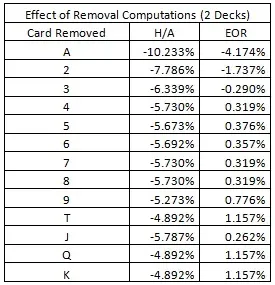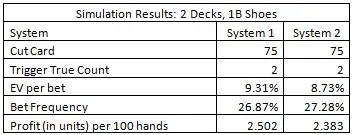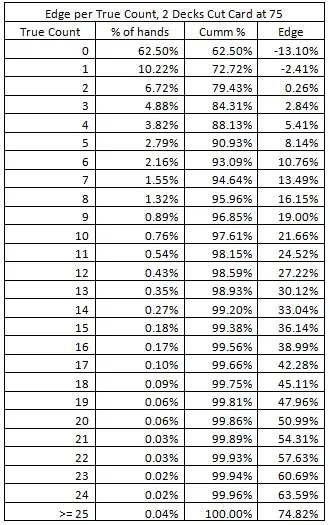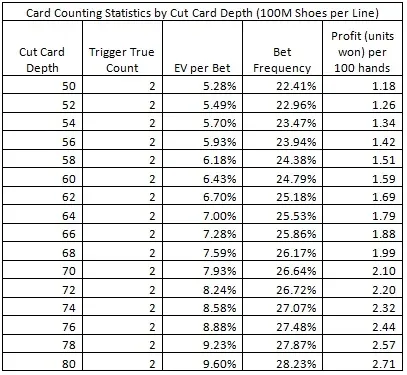The Field Gold 21 (FG21) side bet is one of the more popular side bets available for blackjack. The company that owns it is Fair Trade Gaming, and it is also listed on Shuffle Master’s website. I recall seeing this side bet for many years, and I never thought twice about it. That’s the way it is as a low-level AP. Without the right mindset, it’s easy to overlook what’s right in front of your eyes. The best APs, however, creatively consider every opportunity. After looking at every other major blackjack side bet, this one finally came to the front of the queue.
This wager pays based on the total of the two cards the player is dealt, with an Ace having the value 1 for this bet. Essentially, it models the “Field Bet” in craps – the player wins if his two-card total is 2, 3, 4, 9, 10, 11 or 12. Blackjacks also win. There is only one pay table for this wager, as follows:
- Ace / Jack suited pays 25-to-1
- Two Aces pays 10-to-1
- A total of 3 or 4 pays 3-to-1
- A total of 9 or 10 pays 2-to-1
- A total of 11 or 12 pays 1-to-1
- Any other blackjack pays 3-to-2
- All other bets lose.
The house edge for this side bet is:
- 6.049% for two decks.
- 5.664% for six decks.
It is clear that an Ace is a very powerful card for the player. Not only do Aces make blackjacks more likely, but Aces also make the premium payouts for A-A, A-2 and A-3 more likely. On the other hand, high cards are not good: 9's and ten-valued cards quickly yield totals greater than 12, hence losing hands. The only exceptions to this rule are the Jacks, which are simultaneously good (A/J suited) and bad (too high to make most other hands).
As of this post, Fair Trade Gaming’s website has text that reads, in part: “In creating Blackjack Field Gold 21 … Dr. John M. Gwynn, Jr., professor of computer science at California State University, Sacramento, [determined that] any advantage a counter could obtain from counting … is sufficiently less than the advantage obtained by counting blackjack.” I can only assume he meant that the hi-lo system would not succeed. With its heavy dependence on certain key cards, the Field Gold 21 side bet is extremely vulnerable to a specialized card counting system. This article describes one such system in detail.
The following table gives the effect of removal (EOR) for each card for the double-deck version of FG21. This number describes the change in house edge caused by removing each card from the shoe. As you can see, the edge moves strongly towards the house when Aces are removed:

By looking at the column for EOR, I decided to create a card counting system that gave the Aces a card counting value of -3. To do this, I multiplied each value in the EOR column by 71.874 to get the balanced “System 1” with card counting tags (-3.00, -1.25, -0.21, 0.23, 0.27, 0.26, 0.23, 0.23, 0.56, 0.83, 0.19, 0.83, 0.83). As usual for card counting systems, these tags are given in the order (A, 2, 3, 4, 5, 6, 7, 8, 9, T, J, Q, K).
The reader will no doubt consider it daunting to use System 1 in practice. However, as a baseline counting system, it is worthwhile to see how it performs. In an effort to simplify this system, I also considered the balanced card counting system with tags (-3, -1, 0, 0, 0, 0, 0, 0, 1, 1, 0, 1, 1). I’ll refer to this system as “System 2.” This system is easily used by a card counter of average skill level.
The next step was to write a computer program to simulate using these two systems in live play. My baseline simulation assumed a double-deck version of blackjack. For convenience, I’ll refer to the double-deck game as a “shoe.” After the cards in the shoe were shuffled, I assumed that the cut card was placed after the 75-th card in the shoe. A burn card was dealt and the shoe was played out until the cut card came out. The shoe was then shuffled after that hand and the next shoe was simulated.
The following table gives the results of a simulation of one billion (1,000,000,000) shoes for each system.

These simulations show that the card counter should make the FG21 wager whenever the true count is +2 or higher for the indicated system. With System 1, the player would have an average edge over the house of 9.31% whenever he made the bet and he would make the bet on 26.87% of the hands he played. The player would then win about 2.502 units per 100 blackjack hands. With System 2, the player has an average edge over the house of 8.73% whenever he makes the FG21 bet, and he would make the bet on 27.28% of the hands. The player would then win about 2.383 units per 100 blackjack hands.
As these results show, System 2 performs remarkably well compared to the nearly optimal System 1. To put this in perspective, if a person is playing head’s up double-deck, he may get 200 rounds per hour (or more). If the maximum allowed wager on FG21 is $100, then an advantage player will earn 2.383 x 2 x $100 = $476.60 per hour from card counting the FG21 wager. Even at a $25 maximum bet, the advantage player can earn nearly $120 per hour. A player who is flat betting $25 on ordinary blackjack, so as to not draw attention, and betting $25 every time the FG21 bet is favorable, will earn nearly $100 per hour and will be virtually undetectable.
Over the last few months, I have analyzed many side bets in both baccarat and blackjack. These results make FG21 the most vulnerable widely available side bet I have analyzed.
The following table shows the player edge as a function of the true count for the double-deck version with the cut card placed at 75 cards, using System 2. The purpose of this analysis is to show how the player edge is correlated to the true count. These results are based on a simulation of one billion (1,000,000,000) shoes.

As can be seen from this table, the player edge can become extremely high as the true count rises. Compared to ordinary blackjack card counting, where the player edge reaches a theoretical maximum of about 5%, playing against FG21 can lead to some very large advantages. The player gets an edge in excess of 10% on about 7% of his hands and an edge in excess of 30% on about 1% of his hands. On about 14 hands per 10,000, the player will have an edge in excess of 50%.
The natural defense a casino has towards a card counting form of advantage play is to position the cut card so that fewer cards are dealt between shuffles. The following table gives the EV per bet, bet frequency, and units won per 100 hands for cut card placements from 50 to 80 cards. Each row was arrived at by a simulation of one hundred million (100,000,000) shoes with the cut card placed at the indicated depth. As is evident from this table, the double-deck version of the FG21 wager is highly vulnerable to card counting, even at modest cut card placements. It follows that decreasing deck-penetration is not a viable way of protecting this wager.

From what I understand, this wager is much more common in the six-deck version than the double-deck version. It is therefore worthwhile exploring the performance six-deck version of the wager. For the six-deck game, a computation of the EOR’s again points to System 2 (-3, -1, 0, 0, 0, 0, 0, 0, 1, 1, 0, 1, 1) as being an effective counting system.
I performed a simulation using System 2 of one hundred million (100,000,000) shoes, with the cut card placed at 260 cards (1 deck cut off). This simulation gave a trigger true count of +2 (play FG21 at +2 or higher). In this case, the average edge when the player makes the bet is 6.37%. The player will make a FG21 on about 20.22% of the hands. This results in a net profit of about 1.29 units per 100 hands.
The six-deck version of FG21 is vulnerable and System 2 is a powerful system to use against it. Although the player edge is significantly lower than the two-deck version, it is still very strong. A player playing heads-up, getting 200 rounds per hour at a game that allows a maximum wager of $100 on FG21 can earn about $258 per hour. At a $25 table with 200 rounds per hour, the player will earn about $65 per hour.
The Field Gold 21 side bet is extremely popular. However, it has a significant vulnerability to card counting and that vulnerability needs to be addressed. Because an expert player will be giving up very little to the house on the main blackjack game, such a player can have great longevity flat betting and staying under the radar, while selectively betting FG21 on about 27% of his hands. Such a player can easily produce a profit in excess of $100 per hour at a fast game with a limit of $25 on the FG21 bet.
The following are my recommendations for protecting the FG21 side bet:
- Maintain a low maximum wager.
- Watch for players who place large wagers on the FG21 side bet several rounds into the shoe but don’t make a wager on the first hand.
- Watch out for team play, that is, a table full of players who are betting the FG21 bet together.
- Watch for the other usual tells that a card counting system is being used.
- Lessening the deck penetration between shuffles has minimal effectiveness, and may be cost-negative due to a reduced number of rounds per hour for legitimate play. I recommend against this remedy.
- Change the game itself in ways that make the key cards less powerful.
I would like to thank Stephen How of Discount Gambling for double checking these results and for his independent work which appears on his website.


